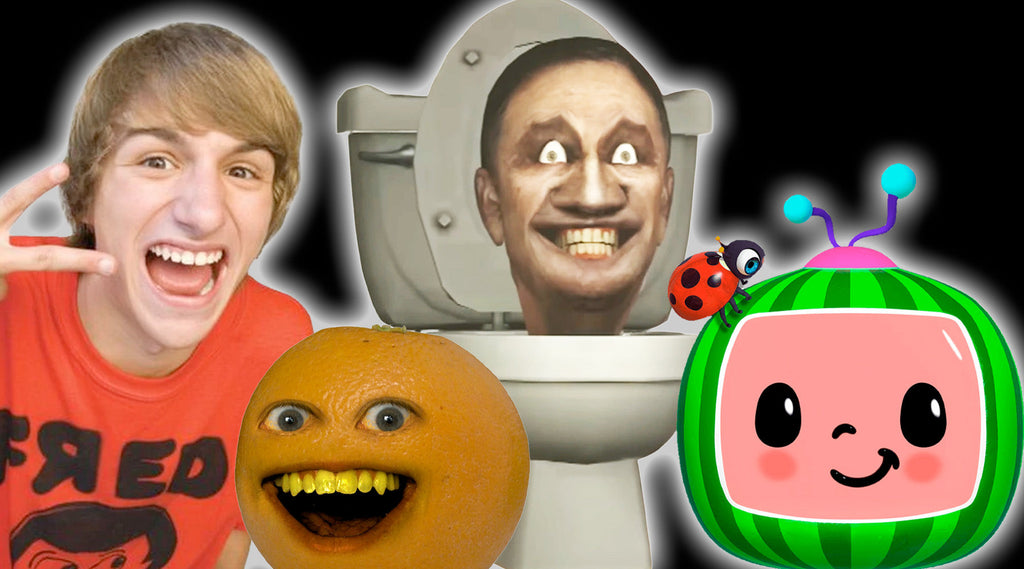
The Evolution of Brain Rot: From Fred Figglehorn to Skibidi Toilet

Brain rot is defined as hyper-stimulating content with fast cuts, vibrant scenes, and a perceived lack of beneficial substance. Parents and educators often point to phenomena like Skibidi Toilet or Cocomelon as the worst offenders of nonsensical entertainment, potentially hindering child development. The short-form kids' content feeding TikTok algorithms seem designed to condition children toward increasingly shorter attention spans. Who are we millennials to talk when our digital childhood was filled with equally bizarre content that we either cringe at now or cherish as nostalgic touchstones?
Every Generation Has Its Chaotic Media
Nonsensical entertainment isn't new. Every generation has its version that got parents concerned and sparked debates about pop media's influence on impressionable minds. As millennials raising the next generation, we had YouTube Poop, Fred's high-pitched screaming, Annoying Orange's kitchen antics, and the psychologically questionable adventures of Charlie the Unicorn. The difference? Our digital landscape had natural boundaries that today's kids don't experience.

Brain Rot from the Golden Internet Age: It Wasn't All Bad
As cringeworthy as it sounds, our early equivalent of brain rot content had some redeeming qualities. User-generated content was revolutionary because it opened doors for people to discover, learn, and create using accessible tools. Unlike today's algorithm-pushed content streams, we had to seek out weird internet content. The family computer in the living room created natural time limits because of the physical limitations. Flash animations on Newgrounds laid the foundations with mindless, random, and edgy content. Salad Fingers gave us collective nightmares, but we had to consciously navigate to these digital spaces rather than having them autoplay endlessly. Our digital explorations had natural stopping points that today's infinite-scroll design eliminates.
From Fred to Algorithm Feeds: What's Changed?
Many of YouTube's earliest viral creators offered little substance. The YouTube Poop era delivered some truly unhinged remix content. Fred became the first YouTuber to hit one million subscribers with his high-pitched tantrums and chaotic editing. Annoying Orange built an empire on talking produce. The common threads between that content and today's brain rot reveal why they're equally addictive.
Why Kids Gravitate to Brain Rot
Just as we couldn't look away from Dancing Badgers or Caramell Dansen videos, today's kids are drawn to their generation's equivalent for similar reasons. The content is stimulating, unpredictable, and triggers dopamine responses. Some universal truths remain: kids generally like weird stuff, and adults will always question younger generations' entertainment choices.
What's fundamentally changed is access and delivery:
- Then: Physical access to shared family computers with natural usage limits
- Now: 24/7 pocket access to unlimited content
- Then: We had to search for content
- Now: Algorithms serve endless personalized content without pauses
- Then: Early internet content often inspired creativity and community
- Now: Content farms optimize for engagement metrics, not enrichment

The Surprising Depth of Skibidi Toilet
Many internet commentators refer to Skibidi Toilet as the epitome of brain rot. For research purposes, I watched the full episodes rather than just the short clips. What I discovered surprised me. Beneath the toilet heads and glitchy dubstep beats lies what feels like a clever metaphor for internet culture.
The story follows The Alliance, humanoid beings with TVs, cameras, and speakers for heads, who are locked in eternal conflict with the Skibidi Toilets. The Alliance represents order, corporate control, and the algorithm-driven internet. They constantly upgrade their tech and approaches. Meanwhile, the Skibidi Toilets embody chaos and creativity, repurposing available resources into something weird yet ingenious. That's exactly what early internet creators did with MS Paint, Flash, and whatever resources they could find. Perhaps the Toilets symbolize the DIY spirit of the old internet fighting to survive in an increasingly curated online space.
Finding Balance: A Millennial Parent's Guide
Brain rot content isn't inherently evil or the sole culprit behind attention span challenges. As with most things in parenting, balance matters most:
- Watch together: Use bizarre content as opportunities to strengthen relational bonds
- Create digital rhythms: Just as our dial-up disconnected when mom needed the phone, Quvo's scheduling features help establish healthy digital patterns that feel natural
- Encourage creation over consumption: The most positive aspect of early internet weirdness was how it inspired us to make our content, Quvo's app timers can limit passive viewing on social media apps while permitting creative apps
- Set content-specific boundaries: Unlike the all-or-nothing parental controls of the early 2000s, Quvo lets you customize access by content category, time of day, and duration
The Millennial Parent Advantage
As the first generation of digital natives raising children, we have a unique perspective. We experienced the internet's evolution from the days of unmoderated forums to curated algorithm experiences. We turned out fine despite watching "Trololol" on repeat. This gives us an advantage in guiding the next generation's digital journey. We understand the potential harms and the creative benefits of online spaces in ways our parents couldn't. With tools like Quvo providing the digital assistance to implement balanced digital boundaries, millennial parents can create online experiences that protect kids from harm while still allowing them the space to discover their generation's weird, wonderful digital culture. They'll look back at Skibidi Toilet the same way we reminisce about Fred, with that perfect blend of cringe and nostalgia that defines a digital childhood.



















